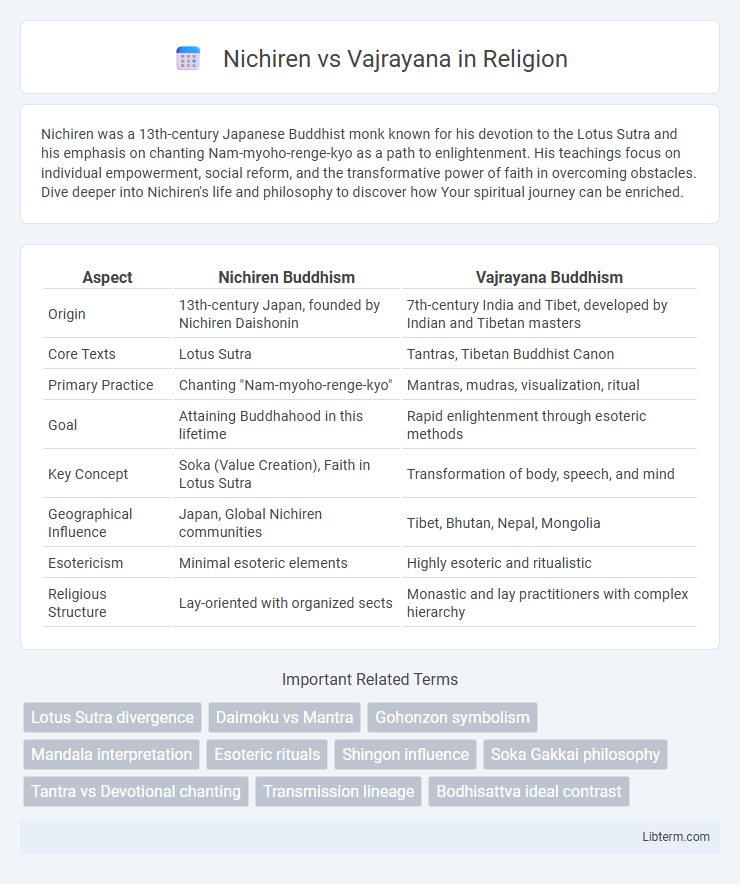Nichiren was a 13th-century Japanese Buddhist monk known for his devotion to the Lotus Sutra and his emphasis on chanting Nam-myoho-renge-kyo as a path to enlightenment. His teachings focus on individual empowerment, social reform, and the transformative power of faith in overcoming obstacles. Dive deeper into Nichiren's life and philosophy to discover how Your spiritual journey can be enriched.
Table of Comparison
| Aspect | Nichiren Buddhism | Vajrayana Buddhism |
|---|---|---|
| Origin | 13th-century Japan, founded by Nichiren Daishonin | 7th-century India and Tibet, developed by Indian and Tibetan masters |
| Core Texts | Lotus Sutra | Tantras, Tibetan Buddhist Canon |
| Primary Practice | Chanting "Nam-myoho-renge-kyo" | Mantras, mudras, visualization, ritual |
| Goal | Attaining Buddhahood in this lifetime | Rapid enlightenment through esoteric methods |
| Key Concept | Soka (Value Creation), Faith in Lotus Sutra | Transformation of body, speech, and mind |
| Geographical Influence | Japan, Global Nichiren communities | Tibet, Bhutan, Nepal, Mongolia |
| Esotericism | Minimal esoteric elements | Highly esoteric and ritualistic |
| Religious Structure | Lay-oriented with organized sects | Monastic and lay practitioners with complex hierarchy |
Historical Origins: Nichiren and Vajrayana
Nichiren Buddhism originated in 13th-century Japan through the teachings of Nichiren Daishonin, emphasizing devotion to the Lotus Sutra as the ultimate truth. Vajrayana Buddhism, also known as Tantric or Esoteric Buddhism, developed between the 7th and 8th centuries in India and Tibet, incorporating complex rituals, mantras, and meditation techniques aimed at rapid enlightenment. While Nichiren centers on scriptural faith and chanting, Vajrayana integrates symbolic practices and tantra within its historical lineage.
Core Doctrines Compared
Nichiren Buddhism emphasizes the exclusive practice of chanting "Nam-myoho-renge-kyo" to attain enlightenment and the centrality of the Lotus Sutra as the ultimate teaching. Vajrayana Buddhism incorporates esoteric rituals, mantras, and visualization techniques aimed at rapid transformation toward Buddhahood, with a focus on tantric texts like the Guhyasamaja Tantra. Both traditions uphold the principle of attaining enlightenment within one's lifetime but differ in doctrinal methods and scriptural authorities.
Key Texts and Scriptures
Nichiren Buddhism centers on the Lotus Sutra (Saddharma Pundarika Sutra) as the ultimate teaching, emphasizing chanting "Nam-myoho-renge-kyo" to invoke its power. Vajrayana Buddhism relies heavily on esoteric texts like the Tibetan Book of the Dead (Bardo Thodol), the Guhyasamaja Tantra, and various other tantras that guide ritual practices and meditation techniques. Key Vajrayana scriptures often focus on transformative rituals and visualization, contrasting with the Lotus Sutra's emphasis on faith and devotion in Nichiren practice.
Central Practices and Rituals
Nichiren Buddhism centers on the chanting of the daimoku, "Nam-myoho-renge-kyo," as a primary practice to invoke the Lotus Sutra's enlightenment. Vajrayana emphasizes complex rituals including mantra recitation, visualization of deities, and mandala offerings to accelerate spiritual awakening. Both traditions incorporate meditation but differ significantly in ritualistic complexity and symbolic tools employed.
Concept of Enlightenment
Nichiren Buddhism emphasizes attaining enlightenment through the chanting of the "Nam-myoho-renge-kyo" mantra and faith in the Lotus Sutra, viewing enlightenment as a realization of the inherent Buddha nature within every individual. Vajrayana Buddhism perceives enlightenment as a swift transformation of the mind and body achieved through esoteric practices, rituals, and visualization techniques, often guided by a guru. While Nichiren centers enlightenment on faith and the power of the sutra, Vajrayana stresses direct experiential realization through tantric methods.
Role of the Guru vs. Teacher
In Nichiren Buddhism, the teacher functions as a guide who helps practitioners understand and chant the Lotus Sutra, emphasizing individual practice and enlightenment through faith and devotion. Vajrayana Buddhism places profound importance on the guru or lama, viewing them as an essential spiritual master who embodies the Buddha and transmits esoteric teachings critical for advanced tantric practices. The guru in Vajrayana is considered indispensable for initiation and transformation, while Nichiren teachings prioritize accessible instruction and personal commitment to the sutra.
Use of Mantras and Chants
Nichiren Buddhism emphasizes the chanting of "Nam-myoho-renge-kyo" as the core mantra, believed to invoke the universal law and transform the practitioner's life. Vajrayana Buddhism extensively uses a variety of mantras, such as "Om Mani Padme Hum," to invoke deities, harness spiritual energies, and aid in meditation practices. While Nichiren focuses on a single mantra for devotion and awakening, Vajrayana incorporates multiple chants combined with visualization techniques to achieve enlightenment.
Symbolism and Iconography
Nichiren Buddhism centers on the Gohonzon, a mandala inscribed with Chinese and Sanskrit characters symbolizing the Lotus Sutra's universal enlightenment, serving as a focal point for chanting Nam-myoho-renge-kyo. Vajrayana Buddhism employs intricate iconography including mandalas, thangkas, and ritual objects like vajras and bells, representing complex philosophical concepts such as the union of wisdom and compassion. Symbolism in Vajrayana often features deities embodying enlightened qualities, while Nichiren's iconography emphasizes textual devotion and the transformative power of the sutra itself.
Community Structure and Organization
Nichiren Buddhism organizes its community around local temples led by ordained priests who guide lay followers through chanting and study of the Lotus Sutra, fostering a cohesive, grassroots network primarily centered on individual devotion and local group activities. Vajrayana Buddhism features a hierarchical structure led by gurus or lamas, with monastic institutions playing a crucial role in preserving esoteric teachings and conducting complex rituals, emphasizing initiation and direct transmission within close teacher-disciple relationships. The Vajrayana community often integrates both monastic and lay practitioners in ritual practice, while Nichiren emphasizes accessible chanting practices for all believers within community-focused organizations like Soka Gakkai.
Modern Global Presence and Influence
Nichiren Buddhism has a significant modern global presence, especially in Japan, the United States, and parts of Southeast Asia, with organizations like Soka Gakkai International promoting peace activism and cultural exchange. Vajrayana Buddhism, encompassing Tibetan and Bhutanese traditions, maintains strong influence in the Himalayan region and has expanded globally through centers in North America, Europe, and Australia, emphasizing esoteric practices and rituals. Both traditions leverage global networks and modern communication to sustain and grow their international communities, adapting ancient teachings to contemporary contexts.
Nichiren Infographic

 libterm.com
libterm.com